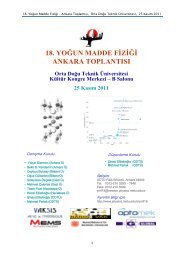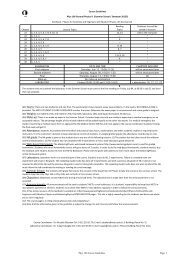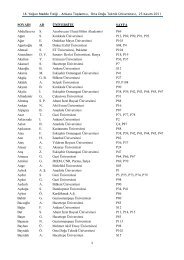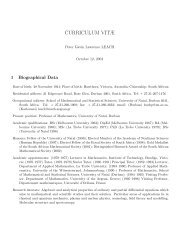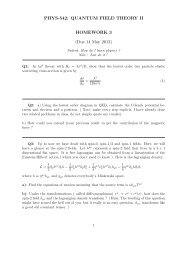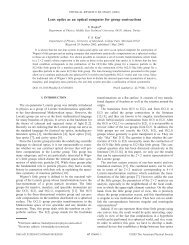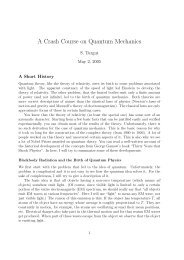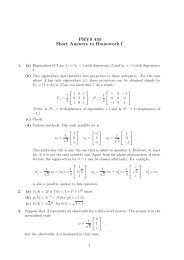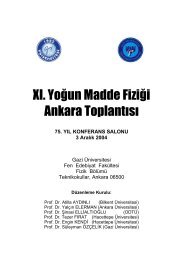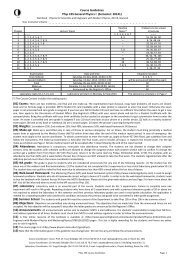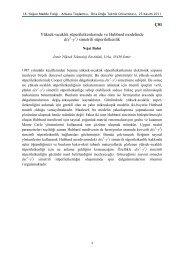SExtractor Draft - METU Astrophysics
SExtractor Draft - METU Astrophysics
SExtractor Draft - METU Astrophysics
- No tags were found...
Create successful ePaper yourself
Turn your PDF publications into a flip-book with our unique Google optimized e-Paper software.
190.040599 0.260856 0.483068 0.260856 0.0405990.006319 0.040599 0.075183 0.040599 0.006319The CONV keyword appearing at the beginning of the first line tells <strong>SExtractor</strong> that the filecontains the description of a convolution mask (kernel). It can be followed by NORM if themask is to be normalized to 1 before being applied, or NONORM otherwise 11 . The followinglines should contain an equal number of kernel coefficients, separated by of characters. Coefficients in the example above are read from left to right and top to bottom,corresponding to increasing NAXIS1 (x) and NAXIS2 (y) in the image. Formatting is free, andnumber representations like -0.14, -0.1400, -1.4e-1 or -1.4E-01 are equivalent. The widthof the kernel is set by the number of values per line, and its height is given by the number oflines. Lines beginning with “#” are treated as comments.6.3 ThresholdingThresholding is applied to the background-subtracted, filtered image to isolate connected groupsof pixels. Each group defines the approximate position and shape of a basic <strong>SExtractor</strong> detectionthat will be processed further in the pipeline. Groups are made of pixels whose values exceedthe local threshold and which touch each other at their sides or angles (“8-connectivity”).6.3.1 Configuration parameters.Thresholding is mostly controlled through the DETECT THRESH and DETECT MINAREA keywords.DETECT THRESH sets the threshold value. If one single value is given, it is interpreted as athreshold in units of the background’s standard deviation. For example:DETECT_THRESH 1.5will set the detection threshold at 1.5σ above the local background. It is important to notethat em the standard deviation quoted here is that of the unFILTERed image, at the pixel scale.Hence, on images with white Gaussian background noise for instance, a DETECT THRESH of 3.0will be close to optimum if low-pass FILTERing is turned off, but sub-optimum (too high) ifit is on. On the contrary, if the background noise of the image is intrinsically correlated frompixel-to-pixel, a DETECT THRESH of 3.0 (with no FILTERing) wil be too low and will result in apoor reliability of the extracted catalog.Two numbers can be given as arguments to DETECT THRESH, in which case the first one isinterpreted as an absolute threshold in units of “magnitudes per square-arcsecond”, and thesecond as a zero-point in the same units.DETECT_THRESH 27.2,30.0will for example set the threshold at 10 −0.4(27.2−30) = 13.18 ADUs above the local background.DETECT MINAREA sets the minimum number of pixels a group should have to trigger a detection.Obviously this parameter can be used just like DETECT THRESH to detect only bright and “big”sources, or to increase detection reliability. It is however more tricky to manipulate at lowdetection thresholds because of the complex interplay of object topology, noise correlations(including those induced by filtering), and sampling. In most cases it is therefore recommendedto keep DETECT MINAREA at a small value, typically 1 to 5 pixels, and let DETECT THRESH andthe filter define <strong>SExtractor</strong>’s sensitivity.11 If the sum of the kernel coefficients happens to be exactly zero, the kernel is normalized to variance unity.



